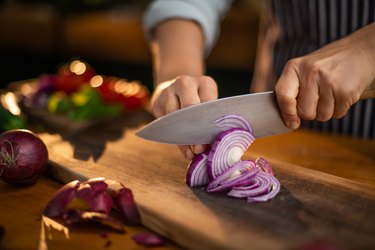
If you're like most people, you've probably shed a few tears while chopping onions.
That's because once onion is cut, it produces a chemical irritant called syn-Propanethial-S-oxide, according to the American Chemical Society. And when this irritant reaches your eyes, it stimulates the tear glands to release tears.
Video of the Day
Video of the Day
While you may have accepted that these alliums will always make you sob, that doesn't have to be the case. Nope, you don't need to cry a river every time you cut into an onion. Here, Ryan Dodge, executive chef at LifeTime's LifeCafe Restaurant, shares seven smart strategies to thwart the waterworks.
And FYI, "Sensitivity to onions varies from person to person," Dodge says. So, when it comes to eliminating tears, certain methods may work better for you than others depending on your level of sensitivity.
1. Sharpen Your Knife
"This is a helpful tip in general for cooking and safety," Dodge says. But a razor-sharp knife does more than make chopping seamless and safer — it also helps lessen the damage to the cells of the onion, which can reduce the release of the chemical irritant.
2. Fan Away the Fumes
A fan pointing at the onion is one of Dodge's top recommendations for reducing tears. This will help push the irritant in the other direction, i.e., away from your eyes.
Running the exhaust fan might work, but depending on your position, it could also backfire and pull the chemical toward your face and eyes, Dodge says.
For best results, he suggests placing a fan next to you instead.
3. Wear Goggles
To wipe out the weeping, your best bet is to cover your eyes. "Goggles work," Dodge says. That's because they prevent the onion's chemicals from making contact with your tear ducts.
Just make sure the goggles are a good fit (try these, $20 on Amazon.com) as in snug enough to seal out the onion vapors.
4. Chill the Onions Beforehand
"If you want to avoid goggles, refrigerate the onion before cutting it," Dodge says. Try popping it in the fridge just 30 minutes to an hour before you start cooking.
"Basically, the chemical in the onion is not as easily released when it's cold," he explains.
Related Reading
5. Remove the Root
"The strength of the chemical is most concentrated in the root of the onion," Dodge says. By removing the root (the end of the onion with the little hair-like strings), you can help limit your exposure to the irritant.
But be careful to avoid cutting the root in half in the process — which would defeat the purpose — and make sure to dispose of it quickly, he says.
6. Limit Your Exposure to Chopped Onions
Once you've sliced open your onion, turn the other exposed half face down on the cutting board. This should, theoretically, minimize the number of irritants in the air.
Also, after you've diced the first half, set it aside in a bowl on the other side of the kitchen. Again, the idea is to keep the onion's chemicals as far away as possible from your eyes.
Should You Spray the Cutting Board With Vinegar?
Some say that spraying a spritz of vinegar onto your cutting board might help slow down the tear-jerking chemical reaction. Supposedly, the acid in vinegar denatures the enzyme that triggers the production of the irritant.
But Dodge doesn’t necessarily recommend this: “I would avoid that unless you’re looking to add vinegar to the recipe since it’s going to impact the taste and color of the onion,” he says.